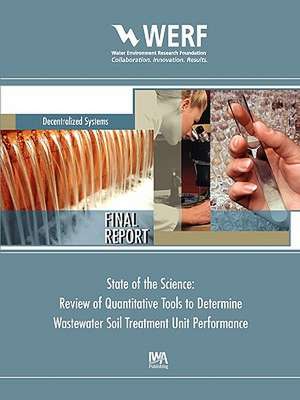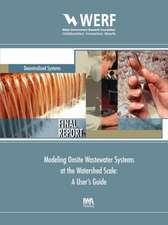State of the Science: Werf Research Report
Autor John McCray, Kathryn Lowe, Mengistu Gezaen Limba Engleză Paperback – 26 aug 2009
Din seria Werf Research Report
- 23%
 Preț: 838.44 lei
Preț: 838.44 lei - 23%
 Preț: 787.71 lei
Preț: 787.71 lei - 23%
 Preț: 785.57 lei
Preț: 785.57 lei - 23%
 Preț: 794.56 lei
Preț: 794.56 lei - 23%
 Preț: 794.08 lei
Preț: 794.08 lei - 23%
 Preț: 793.15 lei
Preț: 793.15 lei - 23%
 Preț: 961.97 lei
Preț: 961.97 lei - 23%
 Preț: 794.08 lei
Preț: 794.08 lei - 23%
 Preț: 813.51 lei
Preț: 813.51 lei - 23%
 Preț: 783.70 lei
Preț: 783.70 lei - 23%
 Preț: 812.10 lei
Preț: 812.10 lei - 23%
 Preț: 790.53 lei
Preț: 790.53 lei - 23%
 Preț: 797.16 lei
Preț: 797.16 lei - 23%
 Preț: 805.94 lei
Preț: 805.94 lei - 23%
 Preț: 789.59 lei
Preț: 789.59 lei - 23%
 Preț: 804.06 lei
Preț: 804.06 lei - 23%
 Preț: 799.56 lei
Preț: 799.56 lei - 23%
 Preț: 800.50 lei
Preț: 800.50 lei - 23%
 Preț: 791.73 lei
Preț: 791.73 lei - 23%
 Preț: 787.24 lei
Preț: 787.24 lei - 23%
 Preț: 798.58 lei
Preț: 798.58 lei - 23%
 Preț: 791.27 lei
Preț: 791.27 lei - 23%
 Preț: 804.53 lei
Preț: 804.53 lei - 23%
 Preț: 790.53 lei
Preț: 790.53 lei - 23%
 Preț: 787.71 lei
Preț: 787.71 lei - 23%
 Preț: 850.29 lei
Preț: 850.29 lei - 23%
 Preț: 796.49 lei
Preț: 796.49 lei - 23%
 Preț: 795.29 lei
Preț: 795.29 lei - 23%
 Preț: 965.25 lei
Preț: 965.25 lei - 23%
 Preț: 797.64 lei
Preț: 797.64 lei - 23%
 Preț: 976.65 lei
Preț: 976.65 lei - 23%
 Preț: 785.11 lei
Preț: 785.11 lei - 23%
 Preț: 970.22 lei
Preț: 970.22 lei - 23%
 Preț: 786.51 lei
Preț: 786.51 lei - 23%
 Preț: 795.97 lei
Preț: 795.97 lei - 23%
 Preț: 966.46 lei
Preț: 966.46 lei - 23%
 Preț: 796.49 lei
Preț: 796.49 lei - 23%
 Preț: 794.81 lei
Preț: 794.81 lei - 23%
 Preț: 958.90 lei
Preț: 958.90 lei - 23%
 Preț: 805.94 lei
Preț: 805.94 lei - 23%
 Preț: 806.41 lei
Preț: 806.41 lei - 23%
 Preț: 789.85 lei
Preț: 789.85 lei - 23%
 Preț: 792.20 lei
Preț: 792.20 lei - 23%
 Preț: 957.42 lei
Preț: 957.42 lei - 23%
 Preț: 796.69 lei
Preț: 796.69 lei - 23%
 Preț: 966.93 lei
Preț: 966.93 lei - 23%
 Preț: 964.79 lei
Preț: 964.79 lei - 23%
 Preț: 975.24 lei
Preț: 975.24 lei
Preț: 799.56 lei
Preț vechi: 1038.40 lei
-23% Nou
Puncte Express: 1199
Preț estimativ în valută:
153.04€ • 166.30$ • 128.64£
153.04€ • 166.30$ • 128.64£
Carte tipărită la comandă
Livrare economică 16-22 aprilie
Preluare comenzi: 021 569.72.76
Specificații
ISBN-13: 9781843393580
ISBN-10: 1843393581
Pagini: 180
Dimensiuni: 210 x 279 x 10 mm
Greutate: 0.45 kg
Editura: IWA Publishing (Intl Water Assoc)
Seria Werf Research Report
ISBN-10: 1843393581
Pagini: 180
Dimensiuni: 210 x 279 x 10 mm
Greutate: 0.45 kg
Editura: IWA Publishing (Intl Water Assoc)
Seria Werf Research Report



